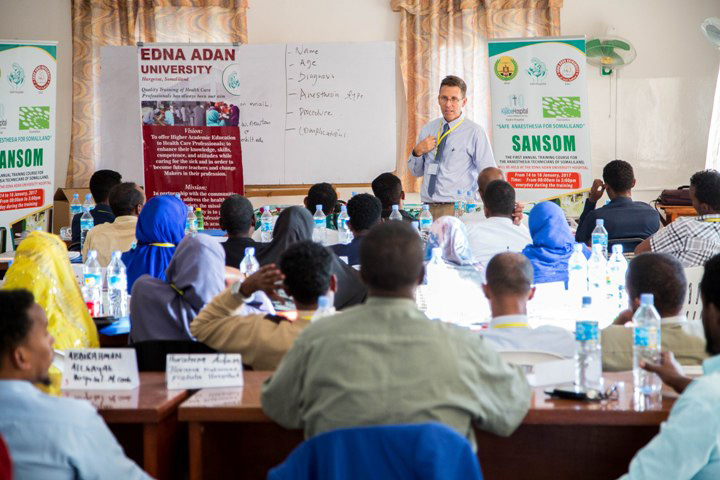Safe Anaesthesia in Somaliland, SANSOM

The World Health Organization (WHO) and World Bank expect that by 2026, the burden of diseases requiring surgery and anaesthesia will eclipse that of HIV, tuberculosis and malaria (measured in disability adjusted life-years). However surgery and anaesthetic care has long been “the neglected stepchild of global health”. (1)
The global volume of major surgery in 2004 was between 187 and 281 million cases, meaning approximately one in every 25 people underwent an operation requiring anaesthesia. It is estimated that five billion people worldwide do not have access to surgery, let alone safe anaesthesia. 75% of major operations were performed in the wealthiest third of the world’s countries, while the poorest third of the world’s population underwent only 3.5% of operations. This reflects a profound disparity in access to essential surgery and safe anaesthesia and a large, untreated global burden of disease.
After decades of civil war, the challenges faced by Somaliland are huge. With a poorly functioning health system there is a lack of education, equipment, supplies, and skilled health personnel and very few facilities in rural areas.
An anaesthesia training programme for Somaliland was instigated three years ago by Dr Mark Newton, Associate Clinical Professor based at Kijabe Hospital, Kenya, but once the nurse anaesthetists got back to the more rural hospitals they had little or no anaesthesia equipment to work with. This has not only been a problem for the hospitals and the patients but also does not encourage the newly qualified anaesthesia providers to stay in country.
We have partnered with Diamedica, UK on an innovative project that aims to make major improvements in anaesthesia provision and care in rural areas where standards are lower and few funds are available. The provision of general anaesthesia in rural regional areas can be made much safer and readily accessible by the use of equipment which has been specially designed for such difficult circumstances.
The project, called SANSOM, provided CME training and equipped the anaesthetic nurses with appropriate equipment before they returned to the rural hospitals. Pairs of trained anaesthetic nurses can thus provide care in a rural setting.
The provision of appropriate medical equipment that is simple, robust and long-lasting is a crucial part of this project, along with training and follow up.
Diamedica manufactures anaesthesia machines designed for challenging environments, and these, along with medical kits which included Lifebox pulse oximeters were given to eight hospitals in Somaliland.
Critically, the anaesthesia machines function well in places susceptible to power failures, or where a reliable supply of oxygen is unavailable, as is the case in Somaliland – and many other LMICs.
Specifically, the DPA02 anaesthesia machines donated continue to function when the electricity fails, and the oxygen concentrators also provided create their own oxygen. In addition, since the anaesthesia machines are portable, they may be used for outreach work, if necessary.
Through this project, delivery of safe anaesthesia for general surgery and safe emergency obstetric care in rural hospitals and clinics will save the lives of thousands of vulnerable women and babies.
A group training programme has been completed as part of Phase 1 of the project for 34 anaesthesia technicians and safe anaesthesia kits have been provided to eight hospitals.
http://www.ghjournal.org/access-to-safe-anesthesia-a-global-perspective/
Photo Credits: Tim Bekir